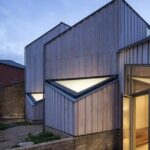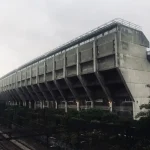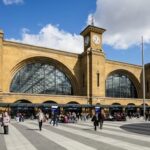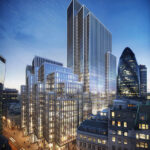Pascal Bronner, Architecture, Building, London, Design, Image, Project
Pascal Bronner : Architect
Work by student at The Bartlett School of Architecture, UCL
Pascal Bronner
Unit 10
Bartlett School of Architecture Student Project
The Iron Fortress – The Illusion of the River Puppet
On a calm afternoon the surface of the iron river perfectly reflects the sky. This camouflage layer becomes the sky for the city of New Malacovia beneath. As a perfect mimic of the real river below it is an illusion of a river to the outside world:

As Pascal’s project unfolds we are introduced to diasporic refugee people, the Moldovians. They make their cities almost invisibly within our cities, they power their cities with potatoes, and occasionally a clue to the Moldovians existence is found within our familiar landscapes. The narrative shows us their furniture, the spaces of their cities, their customs and their stylistic concerns. As the narrative reaches its last “reveal” we suddenly become aware that the Moldovians are very small indeed and that the model we are looking at is not a model at all – it is the city.
Model of a portable New Malacovia
The chance for every Malacovian to carry a blueprint of the Malacovian Landscape. This blueprint is used to form new colonies and settlements around the world and aids the idea of a sustainable culture:
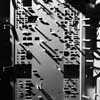
Nevsky Avenue
The city bed of New Malacovia is a vast prairie of windows, which mimic a flattened version of the main boulevard in St Petersburg:
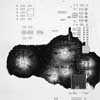
New Malacovia – A Bonsai Landscape
New Malacovia – like any other building, city or landscape – will evolve. Exposed to light, the potatoes begin to sprout. The landscape is a living organism:

The Laboratory – The Hub Of New Malacovia City
From the Laboratory, roots of light sprout and carry heat and energy to the infinite pockets of the underworld. The sunlight that passes through the roots is stored beneath the windows so that at any point, the people of New Malacovia can open them and be flooded with sunlight:

Elevation of the Laboratory
The laboratory penetrates the pixel blanket and is the sole connection point with the outside world. This hub could be likened to a black hole as from the surface it remains invisible as it absorbs all the sunlight in its immediate surroundings:

The Post-it Notes
The laboratory hub is clad in a dense foliage of ideas. These ideas appear as hundreds of thousands of humble post-it notes. The numerous leaves of paper cling to their trunk, the laboratory hub. The hub feeds on light and ideas to grow upwards through the pixel blanket:
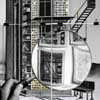
Crafting a Miniature Architecture
The miniature architecture aims to embody the transient and intangible nature of architecture. In theory, it will not only mimic, but aim to replicate the moments so that the viewer can wholly consume its infinite landscape. The observer becomes a traveler:
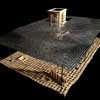
New Malacovia – The Endless Laboratory
This project investigates the design of a sustainable miniature architecture based on a story from ‘The Dictionary of Imaginary Places’. The story records the emigration of a Nogai prince (an inventor) with some of his compatriots during the Crimean War, and their settlement in the Danube Delta, where they rebuilt their lost fatherland. This new settlement became known as Malacovia. The Malacovians were avid inventors and meticulous in the preservation of their ideas. My project extrapolates the narrative to create a 21st century City and an architecture from a tectonic translation of Malacovia.
The universe of New Malacovia is growing to house the ever-increasing amount of ideas and thoughts. If we imagine the beginning of New Malacovia to be an explosion in the laboratory, than we can envisage this imaginary place as constantly expanding. While tools in the laboratory might have begun life at human scale they have since been growing to become the architectural elements of the Endless Laboratory. At any one time, different scales coexist within the Malacovian universe. The components of the expanding landscape have evolved over time, to accommodate their tectonic function within this architecture. A process of natural selection has meant that the strongest ideas conceived in the laboratory have grown to become tectonic characters.
The prince was born in Crimea, an island of rich pastures, but he spent his youth in St. Petersburg. As a consequence, New Malacovia became a hybrid of rural and urban landscape taking elements from both places. The city bed of New Malacovia is a vast prairie of windows, which mimic a flattened version of the main boulevard in St Petersburg. The New Nevsky Avenue stretches to infinity in the river valley.
A second river formed of a blanket of pixels made of iron foil suspended on fine vertical pins, camouflages the city of New Malacovia. The bottom of each pin penetrates a buoyant cork so that the surface blanket effectively becomes a puppet of the much shallower original river. The void created between the fake pixel-river and the real river is occupied by the Malacovians. The original Danube River remains a body of water beneath New Malacovia, and takes the weight of the entire city.
On a calm afternoon the surface of the iron river perfectly reflects the sky. This camouflage layer becomes the sky for the city of New Malacovia beneath. As a perfect mimic of the real river below it is an illusion of a river to the outside world. The city becomes an iron fortress, in terms of the materiality of the iron pins and the fortified pixel blanket, protecting the infinite archive of ideas.
St Petersburg, the culinary capital of Russia introduced the prince to the humble potato – a great energy source and the staple of Russian cuisine. In his laboratory he would experiment with potatoes. By using pins, wire, and foil to draw energy from these spuds, he would turn them into eco-batteries that would eventually power the city, turning Malacovia into a sustainable Bonsai City that feeds on light and ideas, and a blueprint for future generations of Malacovian descent.
Location: The Bartlett School of Architecture, UCL, London, England, UK
London Buildings
Contemporary London Architecture
London Architecture Designs – chronological list
Architecture Tours in London by e-architect
More student work from Bartlett School of Architecture in 2009
The Bartlett School of Architecture, UCL
Wates House
22 Gordon Street
London WC1H 0QB
Neil Spiller – former Professor of Architecture and Digital Theory at The Bartlett
Design: Eric Parry Architects
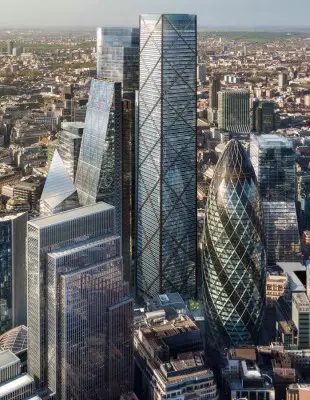
image : DBOX, courtesy Eric Parry Architects
1 Undershaft Tower City of London
UCL Buildings London
Comments / photos for the Pascal Bronner – Bartlett School of Architecture Student Project page welcome

